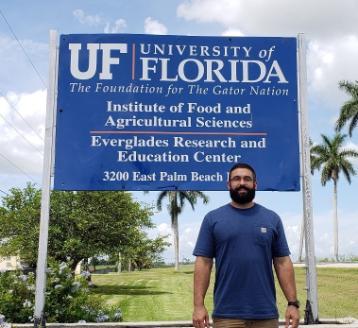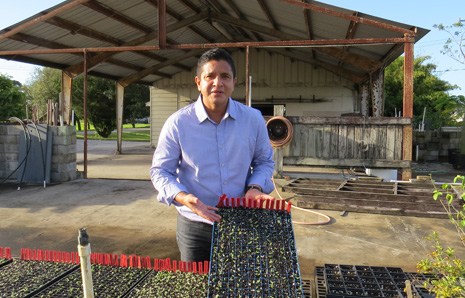Dr. Germán Sandoya
Assistant Professor, Horticultural Sciences
Dr. Germán Sandoya has the responsibility of developing crisphead, butterhead, cos and leaf lettuce cultivars adapted to Florida conditions. Dr. Sandoya’s tasks include interactions with stakeholders, breeders in other states and federal agencies, and vegetable grower organizations (including the Lettuce Advisory Committee and Florida Fruit and Vegetable Association). Dr. Sandoya provides mentorship to graduate students in the Horticultural Sciences Department. His appointment is 70% research and 30% extension.
Program Areas
- Research
- Lettuce improvement for desirable horticultural traits for use in the Ever Glade Agricultural Area:
The mission of the Lettuce Breeding Program at the Everglades Research Education Center is to develop cultivars with good horticultural traits for Florida production.We will be working on improving crisphead (iceberg) and cos (romaine) lettuce cultivars adapted to Florida conditions.
Other lettuce types as leaf and Bibb or Boston are also priorities in our breeding efforts to provide to the growers’ community with newly adapted cultivars to cover the demand of current markets.
We use quantitative genetics to determine the inheritance of important horticultural traits. This information is used to design the appropriate breeding strategy to develop breeding lines or cultivars adapted to Florida.Molecular markers, when possible, will be used to aid the classical breeding approach in order to efficiently select what is suitable for the Ever Glades Agricultural Area.
- Breeding for disease resistance:
Environmental conditions in Florida are exceptional for the development of bacterial diseases such as Bacteria Leaf Spot (BLS) caused by Xanthomonas campestris pv vitians that has been responsible for several million dollars losses to growers in the Everglades Agricultural Area and worldwide.Chemical control of BLS is not currently possible. Therefore we are working on developing material resistant to BLS to be prepared for unexpected outbreaks that occur when the pathogen finds the ideal conditions.
We will also focus on other diseases that are concerns to the growers’ community; such diseases include Cercospora Leaf Spot (Cercospora longissima), Corky Root Rot (Rhizomonas sp.), and Downey mildew (Bremia lactucae) among others.
- Nutrients use efficiency:
Long-term changes on the use of nutrients are expected for any grower worldwide. Currently, growers expect to decrease the amount of fertilizers used for crop production. Therefore, not only the environment can benefit by using fewer nutrients in the soil but also costs can be lowered by using breeding.We are focused on identifying lettuce cultivars that need fewer nutrients for optimal production. We will also focus on improving other agronomic practices such as nutrient use efficiency in collaboration with other scientists at EREC, stakeholders and growers.
More to come…..
- Lettuce improvement for desirable horticultural traits for use in the Ever Glade Agricultural Area:
- Extension
The objective of the extension program is to identify grower’s needs related to improving lettuce and other leafy vegetables cultivars.
Specific objectives of the extension program are to keep up to date on what is happening in the Everglades Agricultural Area (EAA) and how breeding can help to solve other problems with agricultural production for a better and environmental management of crop production.
The lettuce breeding team will actively interact with stakeholders of the lettuce industry: grower's associations, Lettuce Advisory Committee and the Florida Fruit and Vegetable Association.
More to come…
- Graduate Students

Catherine Belisle, PhD Student
Catherine Belisle is a Ph.D. student in the Horticultural Sciences Department working with Dr. Germán Sandoya. Her work is focused on postharvest quality of lettuce and other leafy vegetables produced in the EAA.

Gustavo Kreutz, PhD Student
Gustavo Kreutz is a Ph.D. student in the Horticultural Sciences Department and is working with Dr. Germán Sandoya. He is working in the breeding and genetics of lettuce for nutrient use efficiency; he is also interested in diseases that threaten the lettuce industry at the EAA.

Jesse Murray, MS Student
Jesse Murray is a Master of Science student in the Horticultural Sciences Department working with Dr. Germán Sandoya. His work is related to Fusarium Wilt of lettuce, breeding and genetics. Jesse is also interested in outdoor adventuring, human health and nutrition, and international development. Jesse is also mentored by Dr. Richard Raid.
- Selected Publications
- Sandoya, G., S. Gurunj, D. Short, K.V., Subbarao, R. Michelmore, R.J. Hayes. 2016. Genetics of resistance in lettuce to races 1 and 2 of Verticillium dahliae from different host species. Accepted Euphytica.
-
Sandoya, G., K.V. Subbarao, R.J. Hayes. 2016. Delayed wilt symptoms caused by Verticillium dahliae as a resistance characteristic in iceberg lettuce (Lactuca sativa). Accepted HortScience.
-
Lafta A., T. Turini, G. Sandoya, B. Mou. 2016. Field evaluation of red and green leaf lettuce for heat tolerance. Accepted HortScience.
-
Gurung, S., D. Short, X. P. Hu, G.V. Sandoya, R.J. Hayes, K.V. Subbarao. 2015. Screening of cultivated and wild Capsicum germplasm reveals new sources of Verticillium wilt resistance. Plant Disease 99: 1404-1409.
-
Hu, X. P., S. Gurung, D.P.G. Short, W. Shang, G.V. Sandoya, K.V. Subbarao. 2015. Defoliating and non-defoliating strains of Verticillium dahliae from cotton show high affinity with Races 1 and 2 from lettuce. Plant Disease 99:1173-1720.
-
Gurung, S., D.P.G. Short, G.V. Sandoya, R.J. Hayes, S. Koike, K. V. Subbarao. 2015. Host range of Verticillium isaacii and V. klebahnii from spinach and lettuce. Plant Disease 99: 933-938.
-
Short, D.P.G., G. Sandoya, G.E. Vallad, B. Wu, S. Gurung, C. Xiao, S.T. Koike, R.J. Hayes, K.V. Subbarao. 2015. Dynamics of Verticillium dahliae microesclerotia following flooding, fumigation, and different crop patterns. Phytopathology 105: 638-645.
-
Novakazi, F., P. Inderbitzin, G. Sandoya, R.J. Hayes, A. von. Tiedemann, K.V. Subbarao. 2015. The three lineages of the diploid hybrid Verticillium longisporum differ in virulence and pathogenicity. Phytopathology 105: 662-673.
-
Sandoya, G., M. Buanafina. 2014. Differential responses of Brachypodium distachyon (L) genotypes to insects and fungal pathogens. Physiological and Molecular Plant Pathology 85: 53-64
-
Fescemeyer, H., G. Sandoya, T.A. Gill, S. Okzan, J.H. Mardem., D.S. Luthe. 2013. Maize toxin degrades peritrophic matrix proteins and stimulates compensatory transcriptome responses in fall armyworm midgut. Insect Biochemistry and Molecular Biology Journal 43: 280 – 291.
-
Smith, W.E.C., R. Shivaji, W.P. Williams, D.S. Luthe, G. Sandoya, A.E. Brown. 2012. A maize (Zea mays) Line Resistant to Herbivory Constitutively Releases (E)-β-Caryophyllene. Journal of Economic Entomology 105: 120 – 128.
https://scholar.google.com/citations?hl=en&user=c4epukUAAAAJ

 MENU
MENU